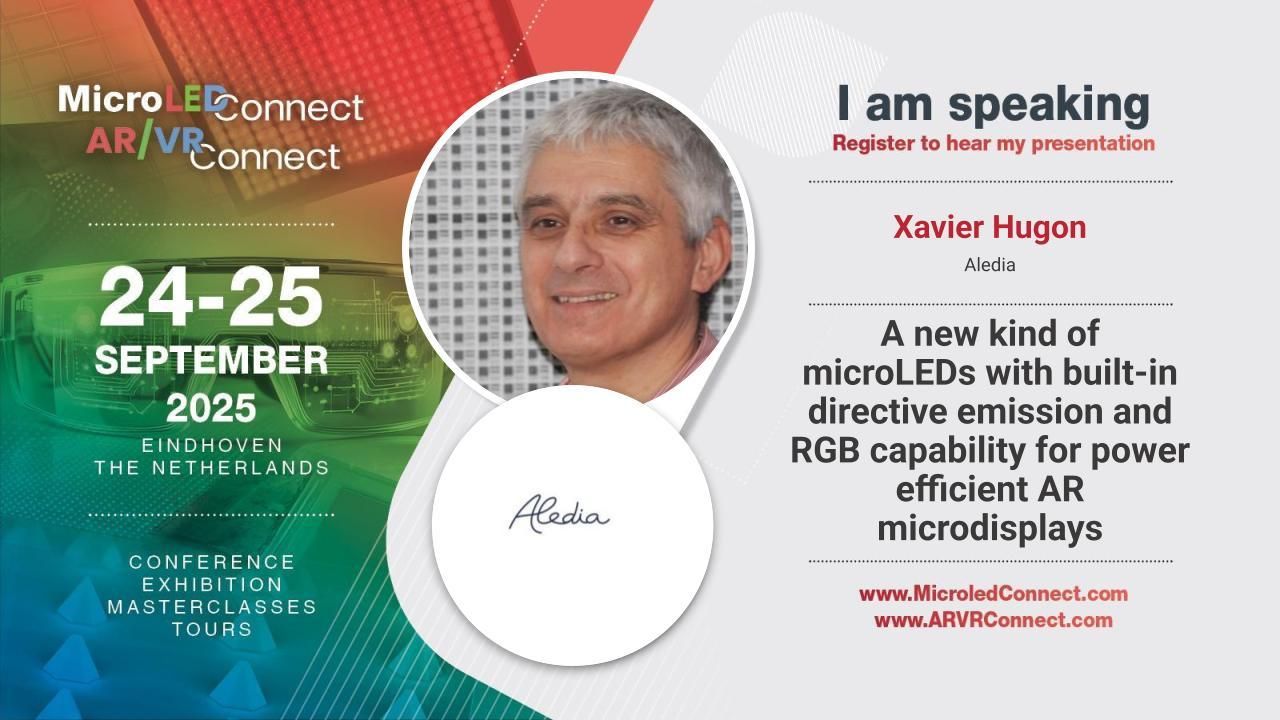

Aledia - A new kind of microLEDs with built-in directive emission and RGB capability for power efficient AR microdisplays
MicroLED/AR/VR Connect September 2025
TechBlick Event
Information
A new kind of microLEDs’ array technology is described and discussed that aims
to answer ultrahigh brightness, narrow optical aperture, low power consumption and
small footprint requirements for Augmented Reality glasses applications.
GaN sub-micrometer (“nano”) rods are directly grown on large-area microelectronic
silicon wafers, followed by the growth of a full LED structure, resulting in self-standing
“nanoLEDs”. NanoLEDs’ size allows to array them in such a way as it builds a
photonic crystal tuned to the desired emission wavelength and designed so that
propagative modes are only allowed into a narrow cone normal to the array plane. It
results in intrinsic directivity of light emission without a need for additional micro-
lenses, meaning that instead of losing 90% of the light not entering the AR glasses
optics (waveguides, for instance) most of it becomes useful raising significantly the
overall system power efficiency. The number of nanoLEDs to maintain efficient
photonic effect is discussed and leads to µm range subpixel capability, other
advantageous consequences of such a resonant coupling are discussed, while single
color arrays results are presented.
Furthermore, quantum well Indium composition can be modulated by playing on local
fill-factor, basically size and pitch of the nanorods, thus changing the quantum well
emission wavelength. By adding fill-factor constrain to photonic crystal design for
directivity it is possible to grow in a single run three colors (R, G, B) patterns with
most of above advantages, including directivity of light emission. Design trade-off and
perspectives are discussed and results on actual microLEDs presented. This
technology opens path to single chip >6000ppi RGB ultra-compact and highly
efficient micro display designs.
to answer ultrahigh brightness, narrow optical aperture, low power consumption and
small footprint requirements for Augmented Reality glasses applications.
GaN sub-micrometer (“nano”) rods are directly grown on large-area microelectronic
silicon wafers, followed by the growth of a full LED structure, resulting in self-standing
“nanoLEDs”. NanoLEDs’ size allows to array them in such a way as it builds a
photonic crystal tuned to the desired emission wavelength and designed so that
propagative modes are only allowed into a narrow cone normal to the array plane. It
results in intrinsic directivity of light emission without a need for additional micro-
lenses, meaning that instead of losing 90% of the light not entering the AR glasses
optics (waveguides, for instance) most of it becomes useful raising significantly the
overall system power efficiency. The number of nanoLEDs to maintain efficient
photonic effect is discussed and leads to µm range subpixel capability, other
advantageous consequences of such a resonant coupling are discussed, while single
color arrays results are presented.
Furthermore, quantum well Indium composition can be modulated by playing on local
fill-factor, basically size and pitch of the nanorods, thus changing the quantum well
emission wavelength. By adding fill-factor constrain to photonic crystal design for
directivity it is possible to grow in a single run three colors (R, G, B) patterns with
most of above advantages, including directivity of light emission. Design trade-off and
perspectives are discussed and results on actual microLEDs presented. This
technology opens path to single chip >6000ppi RGB ultra-compact and highly
efficient micro display designs.
